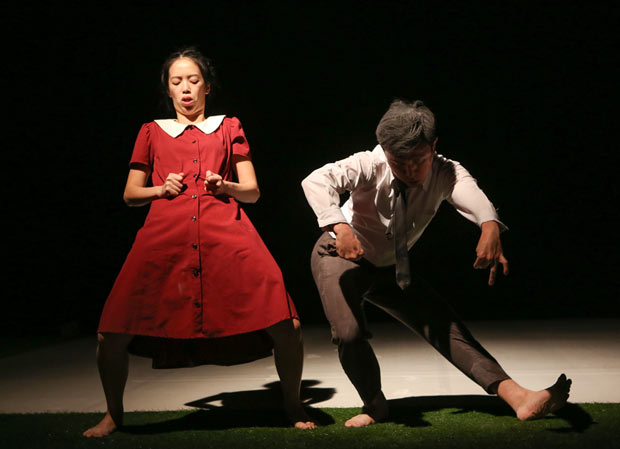
© Julie Lemberger. (Click image for larger version)
Japan Society – 17th Contemporary Dance Showcase: Japan + East Asia
Les Noces, Jimmy & Jack, Tschuss!!Bunny, Hugin/Munin, TransSenses
★★★✰✰
New York, Japan Society
6 January 2017
japansociety.org
Hosted by the Japan Society on the east side of midtown Manhattan, this year’s showcase concentrated on the theme of two: the dynamics of duos. Featuring works from Japan, Korea and Taiwan, the eclectic mixed bill included one world premiere and four works never before seen in North America.
The most memorable work performed was its final act, Les Noces (The Wedding) by Co. Un Yamada, set to Stravinsky’s “Les Noces” and choreographed by the indefatigable Un Yamada. The robust work, performed by Yamada and Llon Kawai, is lively to the point of dizziness, and opens with Yamada balancing on one leg, her other limb shoved into Kawai’s face, her toes wiggling into his cheek.
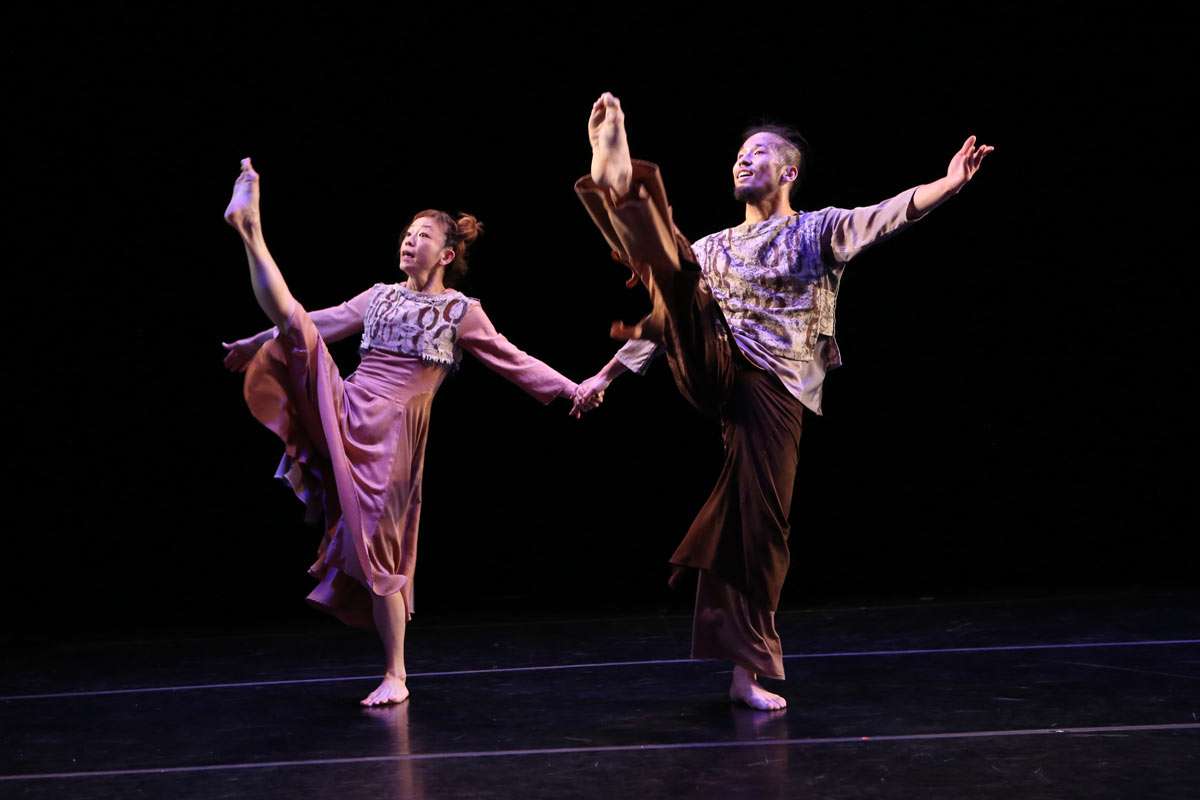
© Julie Lemberger. (Click image for larger version)
It is an absurdist stance to take, and perhaps, to some, so is the institution of marriage. Yamada’s fresh interpretation of Stravinsky’s score is nothing like Bronislava Nijinska’s, so anyone expecting a reflection of the somewhat somber, highly streamlined classicism of the Ballets Russes choreographer will not see those echoes here. Also in creating a work for two people alone, the idea of marriage as part of societal duty, is mostly absent.
Yamada, who came to dance via a childhood diagnosis of rheumatism after years of sports and gymnastics, offers a spirited, sometimes comical, athletic work of muscly invention. The overall mood is joyous, and the execution of the choreography is exquisitely controlled. It takes a lot of precision to pull off orchestrated chaos, and much of the movement is full of extraordinary physical challenges. In one sequence, Yamada leans her back onto his, and he rolls forward and lifts her up, sustaining her body horizontally only with his back. There are goofy sequences, such as Kawai pretending to be a woman dancing and singing before engaging in hyper-virile, masculine, folk dance moves. The work ends with the two rolling their bodies towards each other, ending in a lover’s knot of limbs. If there is a story here about the sacrifice of marriage, certainly the physical effort involved could be interpreted as the “work” of coupledom, but on the whole, it is a boisterous piece that seems more celebratory than otherwise. The sheer physical cunning of both Kawai and Yamada is worth seeing in any form, at any opportunity.

© Julie Lemberger. (Click image for larger version)
Jimmy & Jack by JJBro’s Heung-Ryeol Jun and Sang-Man Pyo – which premiered in Seoul in 2014 – is a whimsical and at times poignant piece about a pair of young boys who copycat each other and, according to the program notes, are “afraid of coming forward, simply because they are different.” Performed by Jun and Pyo, who wear ridiculous wigs and long-john like pajama pants, Jimmy & Jack is performed with narrated input from a female voice, which asks them what they are doing, and why, like a nanny starting to lose her patience.
Like misbehaving children in a playroom, Jun and Pyo goof around, follow each other, and smack each other (often in the nether regions) with childlike innocence. The two perform a pas de deux to Alan Menken’s “Beauty and the Beast,” which of course makes the audience laugh, but it turns out to be a sweet and rather beautiful pas de deux. Mimicry movement aside, there is interesting partnering and Jun and Pyo are swift and agile performers. Towards the end of the piece, the wigs come off and Jimmy and Jack appear to confront their inner selves, and the choreography here is less frivolous and has a longer cadence of choreography less interrupted by gestures and focusing on bigger, broader strokes of movement and partnering.
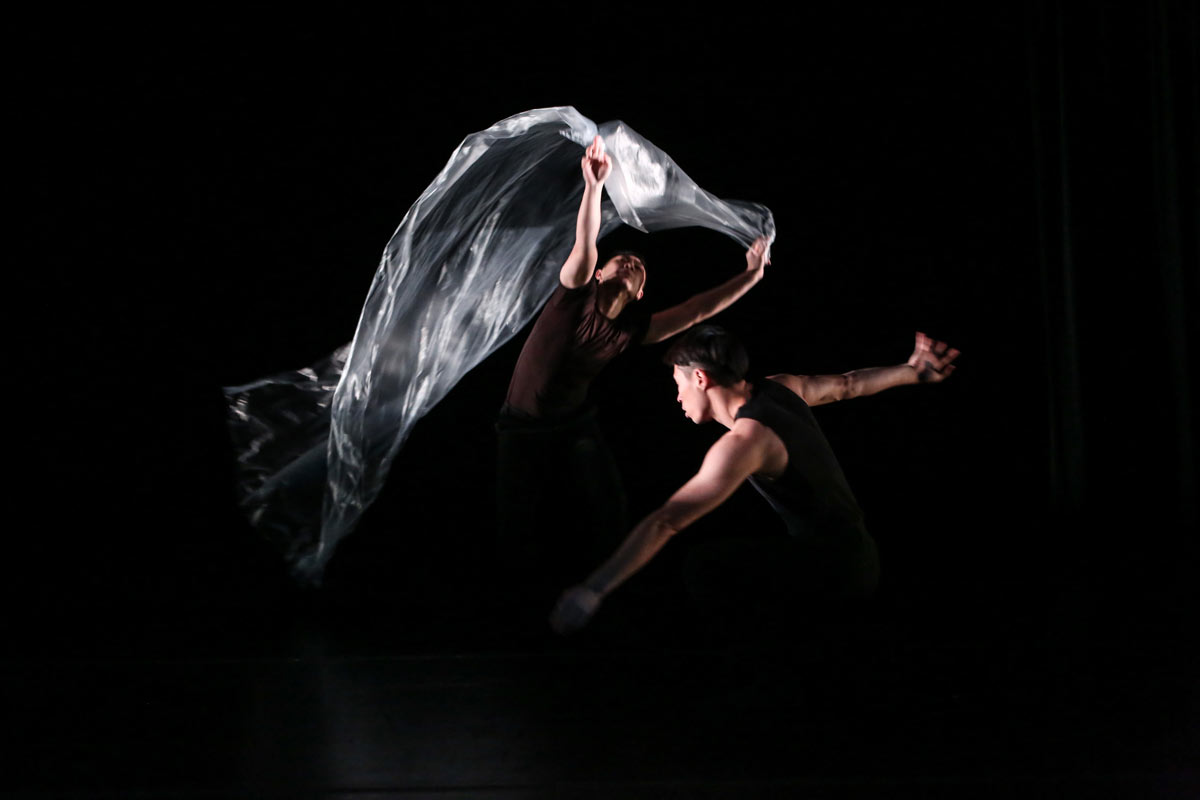
© Julie Lemberger. (Click image for larger version)
Other works on the bill included Tschuss!! Bunny, a work choreographed by Yen-Cheng Liu of Taiwan’s In Theatre and performed by Yi-Wei Tien and Chen-Chih Liao. Boasting strong echoes of Pina Bausch, the dance theater piece is supposed to revolve around the themes of death and goodbye, rebirth and the irreversible passage of time. How successfully this is conveyed by the activities of Tien and Liao, on a strip of AstroTurf, is up for debate. The musical choices – the anti-Pinochet anthem “El Pueblo Unido,” Billie Holiday’s “Gloomy Sunday” and “Topsy” by Django Reinhardt – keep things whimsical even when Tien and Liao look like they are about to murder each other. Hugin/Munin, choreographed by Po-Cheng Tsai and performed by Chien-Chih Chang and Sheng-Ho Chang of Taiwan’s B.Dance, is a moody duet featuring acrobatic lifts and tumbles. Named after Odin’s ravens of thought (Hugin) and memory (Munin), the piece is pensive and even tortured. The two dancers open and close their mouths with pained expressions of a slow-motion tragedy, and seem to illustrate traumatic memories set to rhythmless, ambient, music by Greg Haines. At the end they enclose themselves in a sheet of translucent plastic in the supine position. Perhaps too much knowledge is simply too much.
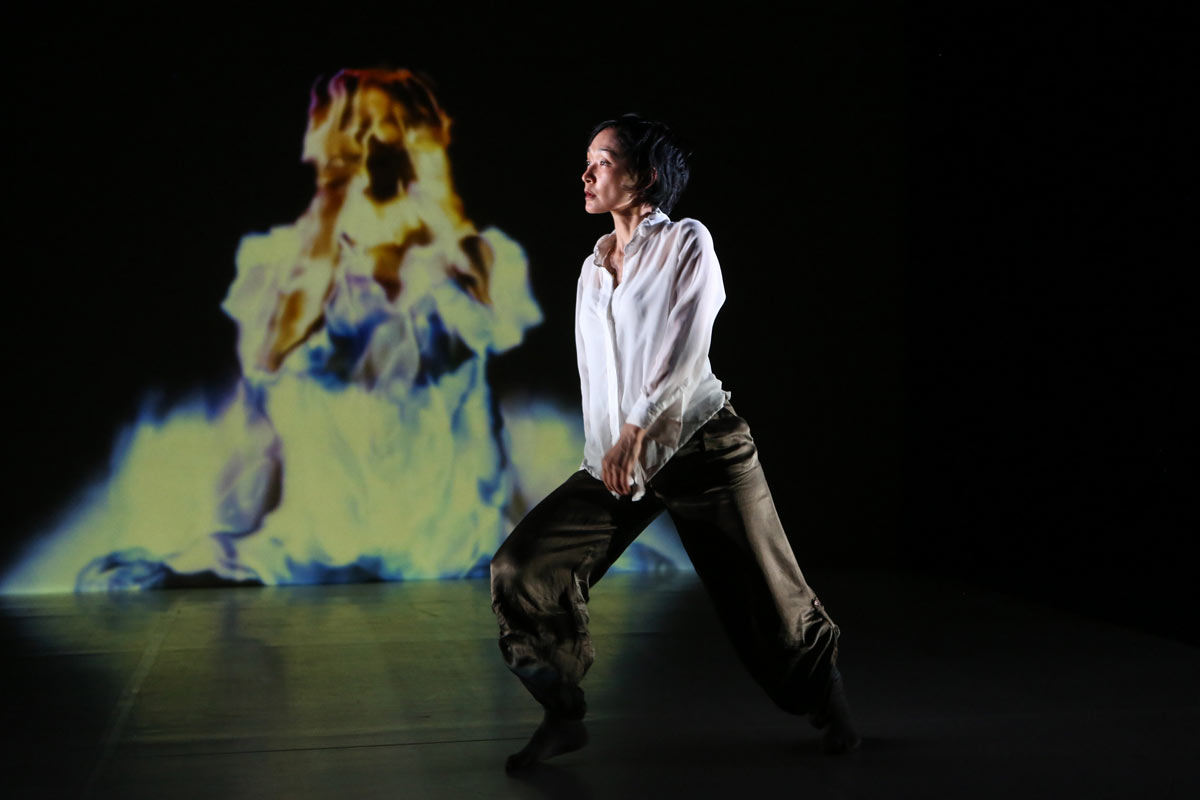
© Julie Lemberger. (Click image for larger version)
TransSenses, a world premiere collaboration between Akiko Kitamura and Navid Navab, is a quiet, meditative work incorporating gestural, interactive sound. With each of Kitamura’s movements, whether quiet, or fast, a sound (or sounds) floods the speakers. Navab, watching Kitamura intensely, twiddles knobs in front of his laptop altering the soundscape live. Much of the sound is reminiscent of a suspenseful cinematic feature: deep bestial echoes of an animal moaning, a large cruise ship groaning before it sinks, etc. Kitamura’s limbs fold towards herself and then away, as if she is in a magnetic vortex and the poles keep changing on her. What starts off quiet and peaceful grows more restless. Near psychedelic visuals fill the backdrop, which, when combined with Navab’s intensely focused figure and Kitamura’s frenzied movements, provides an overstimulating end result, and it is difficult to see the whole instead of its separate parts.













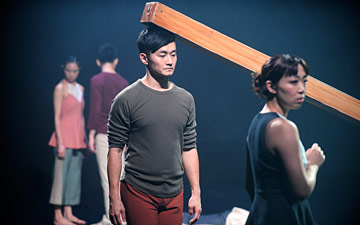



You must be logged in to post a comment.